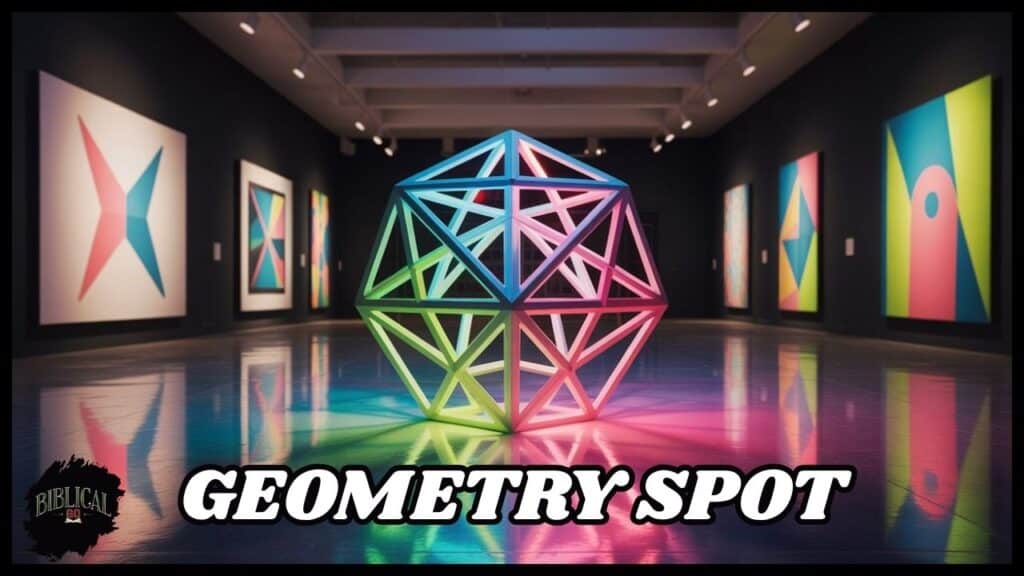Ever wondered why honeycomb cells form perfect hexagons? Or how architects design skyscrapers that won’t collapse? Welcome to the geometry spot where mathematical beauty meets practical necessity.
Geometry isn’t just about memorizing formulas it’s the invisible language that describes everything from the spiral of a nautilus shell to the trajectory of spacecraft.
This comprehensive guide transforms your understanding of geometric concepts from abstract theories into tangible, real-world applications. You’ll discover how ancient Egyptians built pyramids with stunning precision, why GPS systems rely on triangular relationships, and how computer graphics create the digital worlds we love.
Whether you’re a student struggling with angles and polygons or a curious mind seeking to understand the mathematical patterns surrounding us, this geometry spot offers deep insights that make complex concepts accessible and engaging.
Foundations: Ancient Wisdom Meets Modern Understanding
Mesopotamian Origins: Where Practical Geometry Began
The story of geometry begins around 3000 BCE with Mesopotamian surveyors who needed to measure land accurately. These ancient mathematicians didn’t just create pretty patterns they solved real problems. When rivers flooded and erased property boundaries, they used geometric principles to restore order.
Key Mesopotamian contributions:
- Development of the 360-degree circle
- Angular measurements for astronomical observations
- Rectangular surveying techniques still used today
- Pythagorean relationships (before Pythagoras!)
Egyptian Engineering Marvels
The Egyptians transformed geometry from practical tool to architectural wonder. The Great Pyramid of Giza demonstrates their mastery of triangular relationships, symmetry, and spatial understanding. Each limestone block weighs 2.5 tons, yet the structure’s precision rivals modern construction.
Egyptian geometric achievements:
- Right angle construction using 3-4-5 triangles
- Golden ratio applications in pyramid design
- Volume calculations for grain storage
- Circular arc measurements for temple construction
Greek Mathematical Revolution
Euclid’s “Elements” remains the most influential geometry textbook ever written. His logical reasoning approach established geometry as a rigorous science rather than mere measurement. Archimedes expanded these foundations, calculating circumference and developing formulas for polyhedra.
Essential Greek contributions:
- Euclidean geometry axioms and proofs
- Geometric theorems that govern parallel lines
- Conic sections and their properties
- π (pi) approximations through polygon inscriptions
Core Geometric Building Blocks
The Trinity: Points, Lines, and Planes
Every geometric structure begins with three fundamental elements. A point has no dimension it’s pure position. A line extends infinitely in both directions through any two points. A plane contains infinite lines and extends infinitely in all directions.
These seemingly simple concepts create infinite complexity. Intersecting lines form angles. Parallel lines never meet (in Euclidean geometry). Perpendicular lines create right angles of exactly 90 degrees.
Angle Relationships: The Foundation of Measurement
Angles determine how lines interact, creating the building blocks for all geometric shapes. Understanding angle relationships unlocks advanced concepts in trigonometry, engineering, and computer graphics.
| Angle Type | Measurement | Real-World Example |
|---|---|---|
| Acute angle | Less than 90° | Roof pitch for snow shedding |
| Right angle | Exactly 90° | Corner of building foundation |
| Obtuse angle | Greater than 90° | Opening of scissors in use |
| Straight angle | Exactly 180° | Horizon line |
| Reflex angle | Greater than 180° | Clock hands at 4:00 |
Polygon Families: From Simple to Complex
Polygons are closed figures with straight sides. The triangle geometry’s most fundamental polygon appears everywhere because it’s inherently stable. You can’t bend a triangle without changing its side lengths, making it perfect for structural engineering.
Triangle classifications:
- Equilateral triangle: All sides equal, all angles 60°
- Isosceles triangle: Two equal sides, two equal angles
- Scalene triangle: No equal sides, no equal angles
- Right triangle: Contains one right angle
Quadrilaterals offer more variety:
- Square: Four equal sides, four right angles
- Rectangle: Opposite sides equal, four right angles
- Parallelogram: Opposite sides parallel and equal
- Rhombus: Four equal sides, opposite angles equal
Circle Geometry: Perfect Curves and Infinite Possibilities
The circle represents geometric perfection. Every point on a circle sits exactly the same distance from its center the radius. The diameter spans the circle through its center, always twice the radius length.
Essential circle measurements:
- Circumference = 2πr (where r = radius)
- Area = πr²
- Arc length = (θ/360°) × circumference
- Sector area = (θ/360°) × circle area
Advanced Geometric Territories
Trigonometry in Action: Beyond Basic Ratios
Trigonometry transforms right triangles into powerful problem-solving tools. The sine, cosine, and tangent ratios unlock calculations for engineering, navigation, and computer graphics.
Real-world trigonometric applications:
- GPS systems calculate position using triangulation
- Architecture determines roof slopes and structural loads
- Robotics controls arm movements through angular calculations
- Animation creates realistic motion in digital environments
Coordinate Geometry: Plotting Mathematical Relationships
Coordinate geometry merges algebra with geometric visualization. Every point receives unique (x, y) coordinates, transforming abstract relationships into concrete calculations. This breakthrough enables computer graphics, mapping systems, and data visualization.
Coordinate system applications:
- GPS coordinates pinpoint locations globally
- Computer screens display pixels at specific coordinates
- 3D modeling adds z-coordinates for depth
- Graphing calculators plot mathematical functions
Non-Euclidean Geometry: Challenging Ancient Assumptions
For over 2000 years, mathematicians accepted Euclid’s parallel postulate: through any point not on a line, exactly one parallel line exists. Then Poincaré and others discovered this isn’t always true.
Spherical geometry operates on curved surfaces where parallel lines eventually meet. Hyperbolic geometry creates surfaces where infinite parallel lines exist through any given point. These discoveries revolutionized our understanding of space itself.
Real-World Geometric Applications
Architecture and Construction: Building Mathematical Beauty
Architecture transforms geometric principles into livable spaces. Triangular trusses distribute weight efficiently. Circular arches channel forces around openings. Rectangular layouts maximize usable space.
Modern architects use geometry for both form and function:
- Geodesic domes achieve maximum volume with minimum materials
- Structural integrity depends on triangular bracing
- Aesthetic proportions often follow the golden ratio
- Ventilation systems require geometric modeling for efficiency
Engineering Marvels: Mathematical Precision at Scale
Engineering pushes geometric applications to their limits. Bridge designers calculate load distributions using triangular supports. Tunnel engineers bore through mountains following precise geometric paths.
Bridge engineering examples:
- Suspension bridges use parabolic cable curves
- Arch bridges redirect weight through circular or elliptical shapes
- Truss bridges employ triangular frameworks for strength
- Cable-stayed bridges balance forces through angular calculations
Navigation Systems: Triangulation and Global Positioning
GPS systems demonstrate geometry’s practical power. Satellites broadcast signals containing precise time stamps. Your device measures signal travel times, calculating distances to multiple satellites. Triangulation determines your exact position using these distance measurements.
Navigation geometry basics:
- Three satellite distances create a triangular position fix
- Four satellites provide altitude information
- Spherical calculations account for Earth’s curvature
- Error correction uses additional geometric constraints
Medical Imaging: Geometric Reconstruction of Human Bodies
Medical technology relies heavily on geometric principles. CT scanners rotate X-ray sources around patients, collecting thousands of angular projections. Computer algorithms use geometric reconstruction to build 3D images from these 2D slices.
Medical geometry applications:
- MRI scanners create images using magnetic field geometry
- Ultrasound calculates distances using sound wave reflections
- Surgical robots navigate using coordinate systems
- Prosthetic design requires precise anatomical measurements
Geometry’s Digital Revolution
Computer Graphics: Creating Virtual Worlds
Computer graphics transforms mathematical geometric concepts into visual experiences. Every 3D model begins with vertices (points in space), edges (lines connecting points), and faces (polygons forming surfaces).
Graphics rendering process:
- 3D coordinates define object positions
- Transformation matrices handle rotation, translation, and scaling
- Projection algorithms convert 3D scenes to 2D screens
- Lighting calculations use vector geometry for realistic appearance
Robotics: Spatial Awareness Through Mathematics
Robotics systems navigate using geometric calculations. Robot arms move through space following coordinate paths. Autonomous vehicles create geometric maps of their surroundings for safe navigation.
Robotic geometry applications:
- Path planning calculates optimal routes through obstacles
- Inverse kinematics determines joint angles for desired positions
- Collision detection uses geometric boundary calculations
- SLAM (Simultaneous Localization and Mapping) builds geometric environment models
Machine Learning: Pattern Recognition Through Geometric Analysis
Artificial intelligence increasingly relies on geometric understanding. Neural networks process data in high-dimensional geometric spaces. Pattern recognition algorithms identify shapes and relationships in geometric terms.
AI geometry connections:
- Feature spaces organize data using geometric distances
- Clustering algorithms group similar data points geometrically
- Computer vision recognizes objects through geometric features
- Deep learning creates geometric representations of complex patterns

Cultural Geometric Expressions
Islamic Geometric Art: Mathematics as Spiritual Expression
Islamic geometric art demonstrates how mathematical precision creates spiritual beauty. Complex tessellations fill mosque surfaces with infinite patterns that never repeat exactly. These designs reflect Islamic concepts of divine infinity and unity.
Islamic geometric principles:
- Regular polygons form pattern foundations
- Star-and-polygon combinations create complexity
- Symmetry operations generate infinite variations
- Golden ratio proportions enhance visual harmony
Japanese Origami Mathematics: Paper Folding Meets Geometric Proofs
Origami reveals deep connections between art and mathematics. Every fold creates geometric relationships. Complex models require understanding angle bisections, parallel creases, and symmetry operations.
Origami geometry concepts:
- Haga’s theorem enables precise angle trisection
- Kawasaki’s theorem governs flat-foldable patterns
- Maekawa’s theorem determines valley and mountain fold patterns
- Map-folding problems connect to computational geometry
African Geometric Traditions: Fractal Patterns in Daily Life
Traditional African cultures incorporated geometric patterns into architecture, textiles, and ritual objects long before European contact. Many patterns display fractal properties self-similar structures that repeat at different scales.
African geometric examples:
- Bamileke spider webs use hexagonal symmetry
- Shona pottery features spiral and circular motifs
- Ndebele house painting employs triangular and diamond patterns
- Ethiopian church architecture uses geometric stone carving
Surprising Geometric Discoveries
Golden Ratio Appearances: Nature’s Mathematical Signature
The golden ratio (φ ≈ 1.618) appears throughout nature and human creations. This special proportion creates pleasing visual relationships that seem hardwired into human perception.
Golden ratio examples:
- Nautilus shells spiral according to golden ratio proportions
- Flower petals often number in Fibonacci sequence (related to golden ratio)
- Human faces considered attractive often display golden ratio proportions
- Classical architecture incorporates golden ratio in column spacing
Platonic Solids: Perfection in Three Dimensions
Only five polyhedra exist where every face is identical and every vertex looks the same. These Platonic solids fascinated ancient Greeks and continue influencing modern design.
| Platonic Solid | Faces | Shape of Faces | Real-World Examples |
|---|---|---|---|
| Tetrahedron | 4 | Equilateral triangles | Dice, molecular structures |
| Cube | 6 | Squares | Building blocks, salt crystals |
| Octahedron | 8 | Equilateral triangles | Diamonds, fluorite crystals |
| Dodecahedron | 12 | Regular pentagons | Soccer balls, virus capsids |
| Icosahedron | 20 | Equilateral triangles | Geodesic domes, fullerene molecules |
Möbius Strip Mysteries: One-Sided Mathematical Objects
The Möbius strip challenges intuitive understanding of surfaces. Created by twisting a paper strip once before joining its ends, this object has only one side and one edge. Walking along its surface, you’d return to your starting point having visited both “sides.”
Möbius strip properties:
- Single continuous surface with no “inside” or “outside”
- Cutting along the center creates one longer loop
- Topology studies such properties that remain unchanged by stretching
- Applications in engineering for conveyor belts and mechanical linkages
Mastering Geometric Thinking
Visual Learning Strategies: Making Abstract Concepts Concrete
Geometry learning benefits enormously from visual aids and hands-on manipulation. Physical models help students understand spatial relationships that remain abstract in textbooks.
Effective learning tools:
- Manipulatives: Pattern blocks, geometric solids, geoboards
- Interactive software: GeoGebra, Desmos, Sketchpad
- Real-world connections: Architecture walks, nature observations
- Art projects: Creating tessellations, geometric sculptures
Problem-Solving Approaches: Developing Mathematical Reasoning
Geometric problem-solving requires both logical reasoning and creative thinking. Successful students learn to visualize problems, identify relevant relationships, and apply appropriate theorems.
Problem-solving strategies:
- Draw diagrams to visualize spatial relationships
- Identify given information and what needs to be found
- Look for patterns in similar problems
- Work backwards from desired conclusions
- Check answers for reasonableness
Technology Tools: Digital Geometry Exploration
Modern educational software transforms geometry learning through interactive exploration. Students can manipulate shapes dynamically, observing how changes affect measurements and relationships.
Recommended geometry software:
- GeoGebra: Free, comprehensive geometry and algebra tool
- Desmos Geometry: Browser-based construction and exploration
- The Geometer’s Sketchpad: Professional-grade construction software
- Dynamic Geometry software: Cabri, Cinderella, KIG
Geometry’s Expanding Frontiers
Computational Geometry: Algorithms for Geometric Problems
Computational geometry develops efficient algorithms for geometric calculations. This field enables computer graphics, robotics, GIS systems, and CAD software.
Key algorithmic problems:
- Convex hull: Finding the smallest polygon containing all given points
- Voronoi diagrams: Partitioning space based on distance to point sets
- Triangulation: Dividing polygons into triangles for computation
- Collision detection: Determining when moving objects intersect
Topological Data Analysis: Shape Analysis in Big Data
Topology studies properties preserved under continuous deformation. Modern applications analyze data shapes to find hidden patterns in complex datasets.
Topological data applications:
- Medical imaging: Analyzing organ shapes for disease detection
- Social networks: Understanding connection patterns
- Financial markets: Identifying bubble formations and crashes
- Climate science: Modeling atmospheric and oceanic flows
Quantum Geometry: Mathematical Principles in Quantum Computing
Quantum computing relies heavily on geometric concepts. Quantum states exist in high-dimensional geometric spaces, and quantum operations correspond to geometric transformations.
Quantum geometry connections:
- Quantum states as vectors in geometric spaces
- Quantum gates as rotation and reflection operations
- Quantum algorithms navigate geometric probability landscapes
- Error correction uses geometric codes for stability
Comprehensive FAQ Section
What exactly is Geometry Spot and how does it work?
Geometry spot refers to focused areas where geometric concepts intersect with real-world applications. These spots highlight how abstract mathematical ideas become practical tools. Whether studying triangular bridge supports or circular planetary orbits, geometry spots reveal mathematics in action.
Why does geometry matter more than other math subjects?
Geometry uniquely combines logical reasoning with spatial understanding. While algebra manipulates symbols, geometry connects abstract concepts to visual and physical reality. This makes geometric thinking essential for engineering, architecture, computer graphics, and countless other fields.
Which geometric concepts should beginners master first?
Start with fundamental relationships: points, lines, planes, and angles. Master triangle properties, especially right triangles and the Pythagorean theorem. Understanding parallel and perpendicular relationships builds the foundation for advanced topics.
Essential beginner concepts:
- Point, line, plane definitions
- Angle types and measurements
- Triangle classifications and properties
- Parallel and perpendicular line relationships
- Basic polygon identification
How do professionals use geometry in cutting-edge technology?
Computer graphics professionals create realistic 3D environments using geometric modeling. GPS systems calculate positions through triangulation. Robotics engineers program movement using coordinate geometry. Artificial intelligence researchers analyze data in high-dimensional geometric spaces.
What are the most elegant geometric theorems ever discovered?
Euler’s formula (V – E + F = 2) elegantly relates vertices, edges, and faces in any polyhedron. The Pythagorean theorem provides a simple relationship for right triangles. Gauss-Bonnet theorem connects geometry and topology in profound ways.
Conclusion: Geometry’s Endless Possibilities
Geometry surrounds us constantly, from the hexagonal efficiency of honeycomb cells to the parabolic paths of thrown basketballs. This geometry spot exploration reveals how ancient mathematical discoveries continue driving modern innovations.
Understanding geometric principles enhances your ability to navigate our increasingly technical world. Whether you’re appreciating architectural beauty, troubleshooting GPS navigation, or marveling at computer-generated movies, geometry provides the mathematical foundation making it all possible.
The journey through geometric understanding never truly ends. Each concept connects to others, creating an intricate web of mathematical relationships. As you continue exploring, you’ll discover new geometry spots where abstract theory transforms into practical magic, proving that mathematics isn’t just about numbers it’s about understanding the fundamental patterns that shape our universe.
Read more knowledgeable blogs on Biblical Go

Piper McMillan is a devoted writer and Bible enthusiast, offering insightful guides on Bible verses. Her blog provides practical interpretations and reflections, helping readers deepen their faith and understanding of Scripture through accessible and inspiring content.



